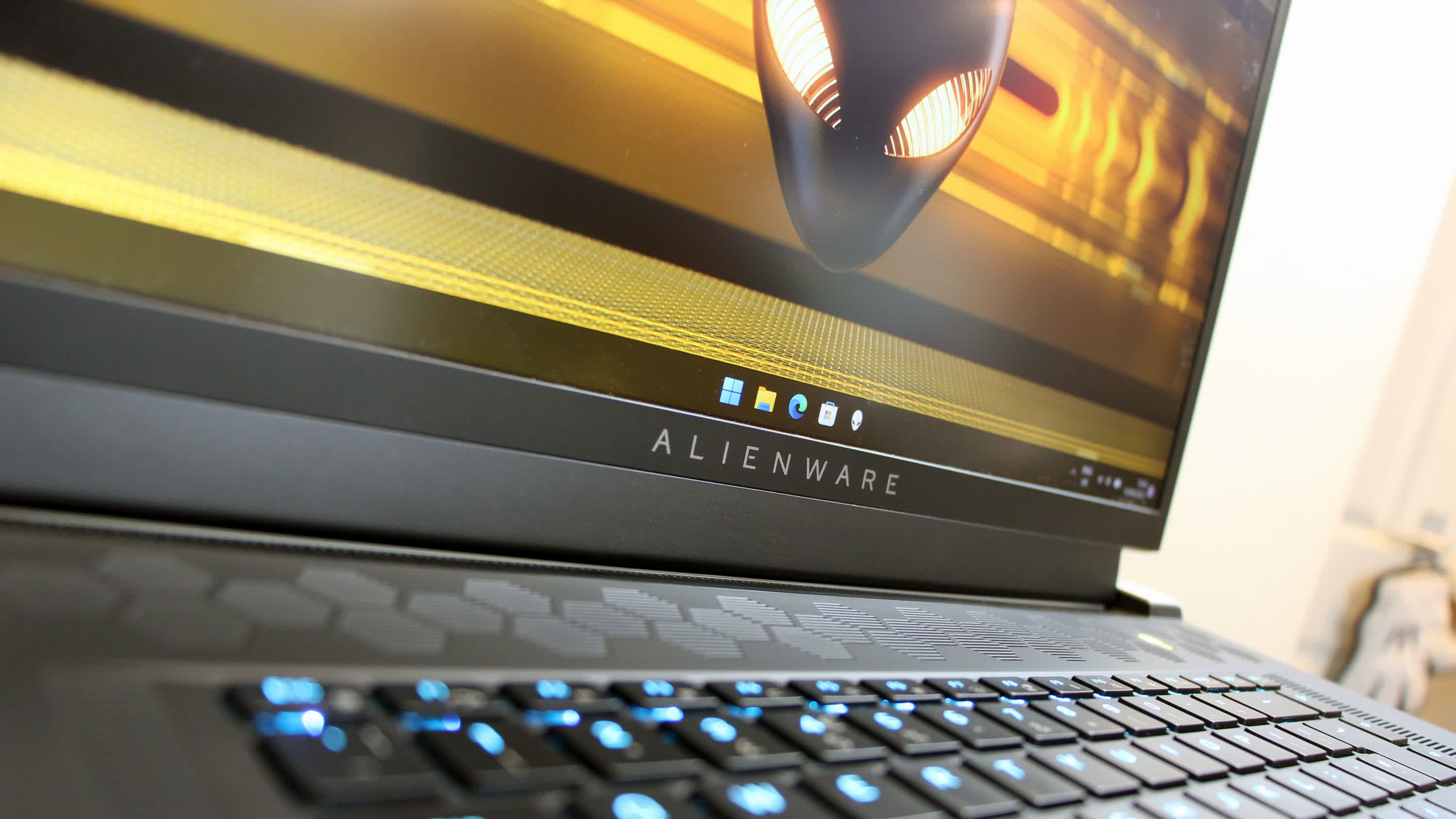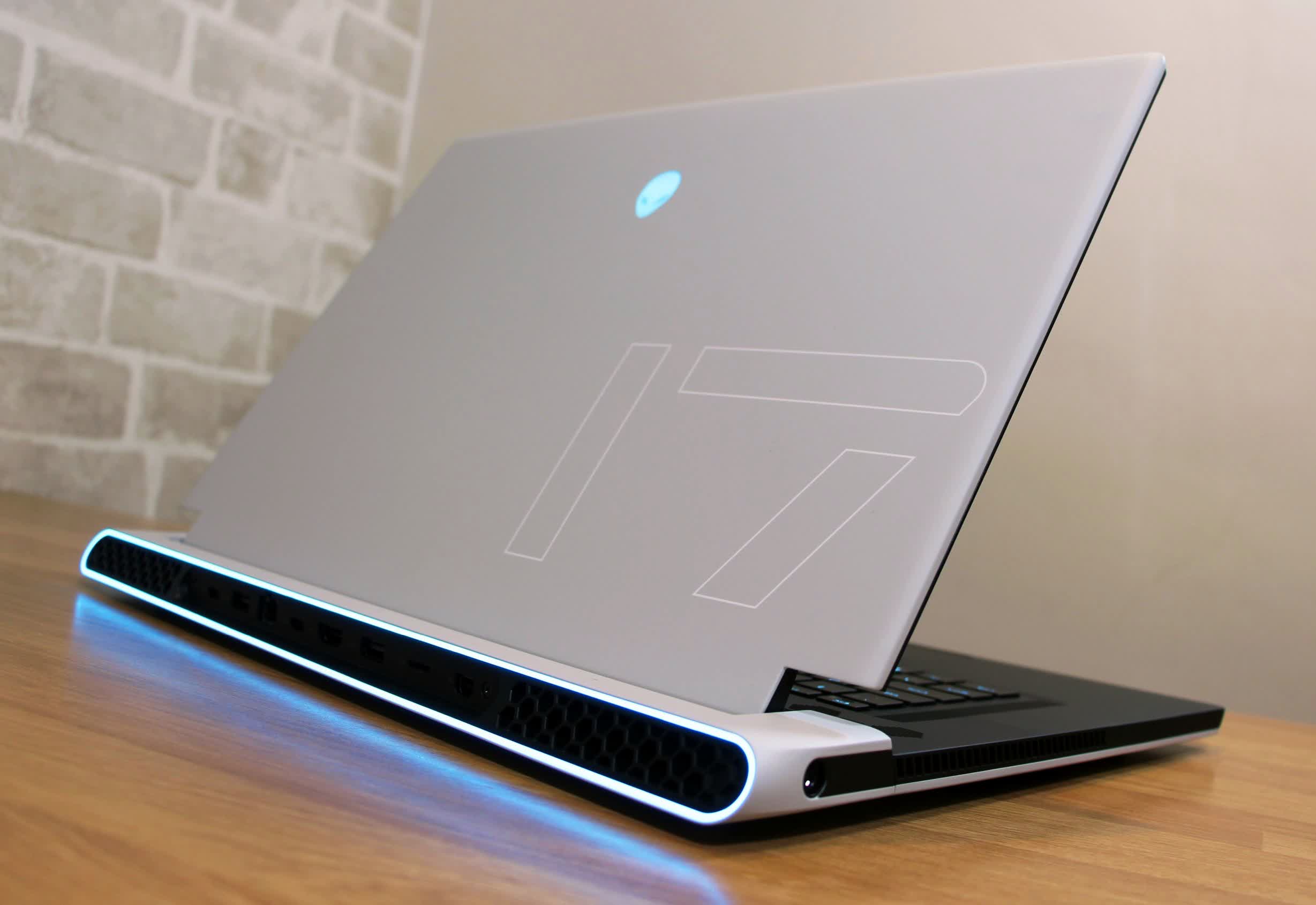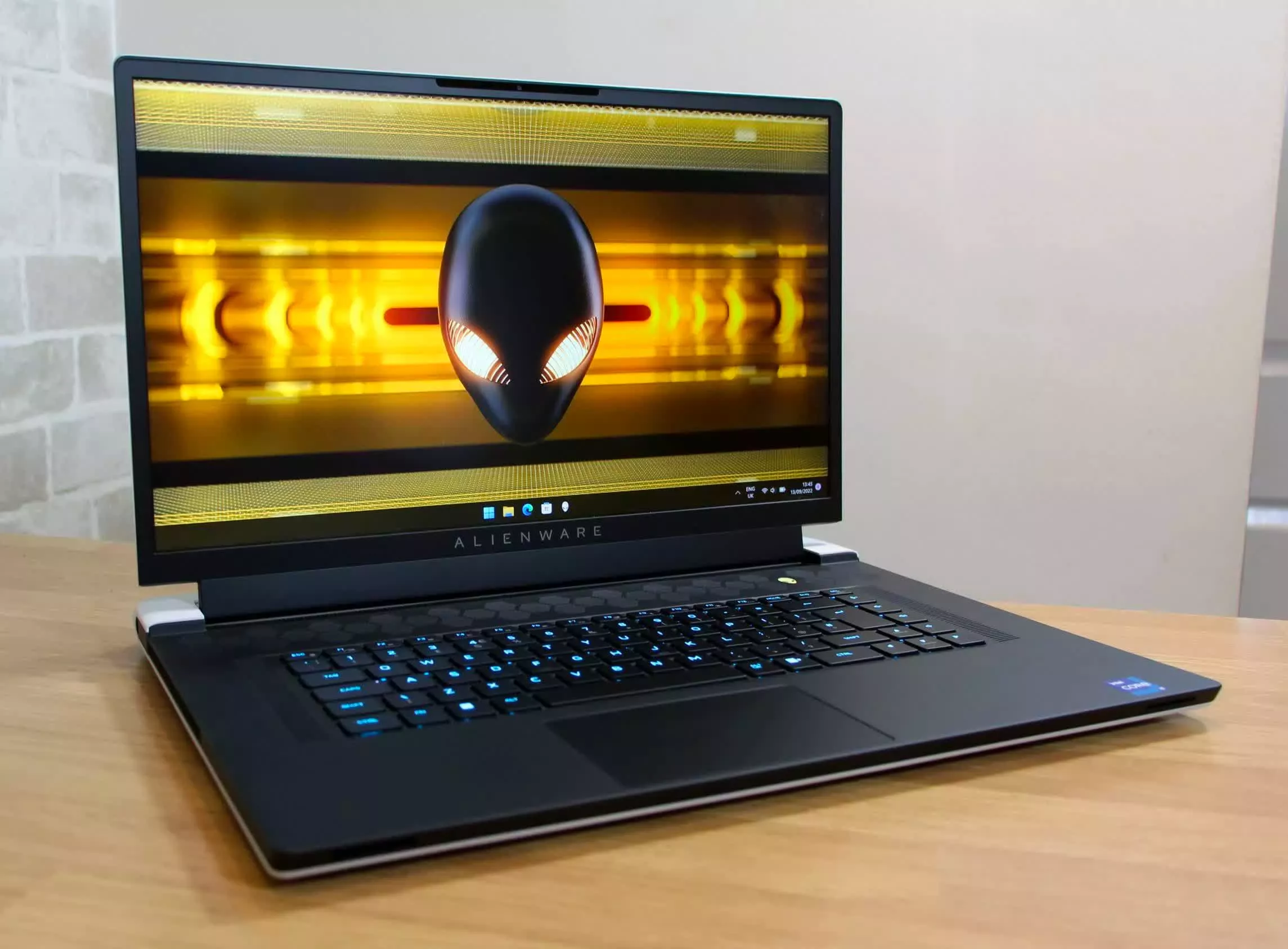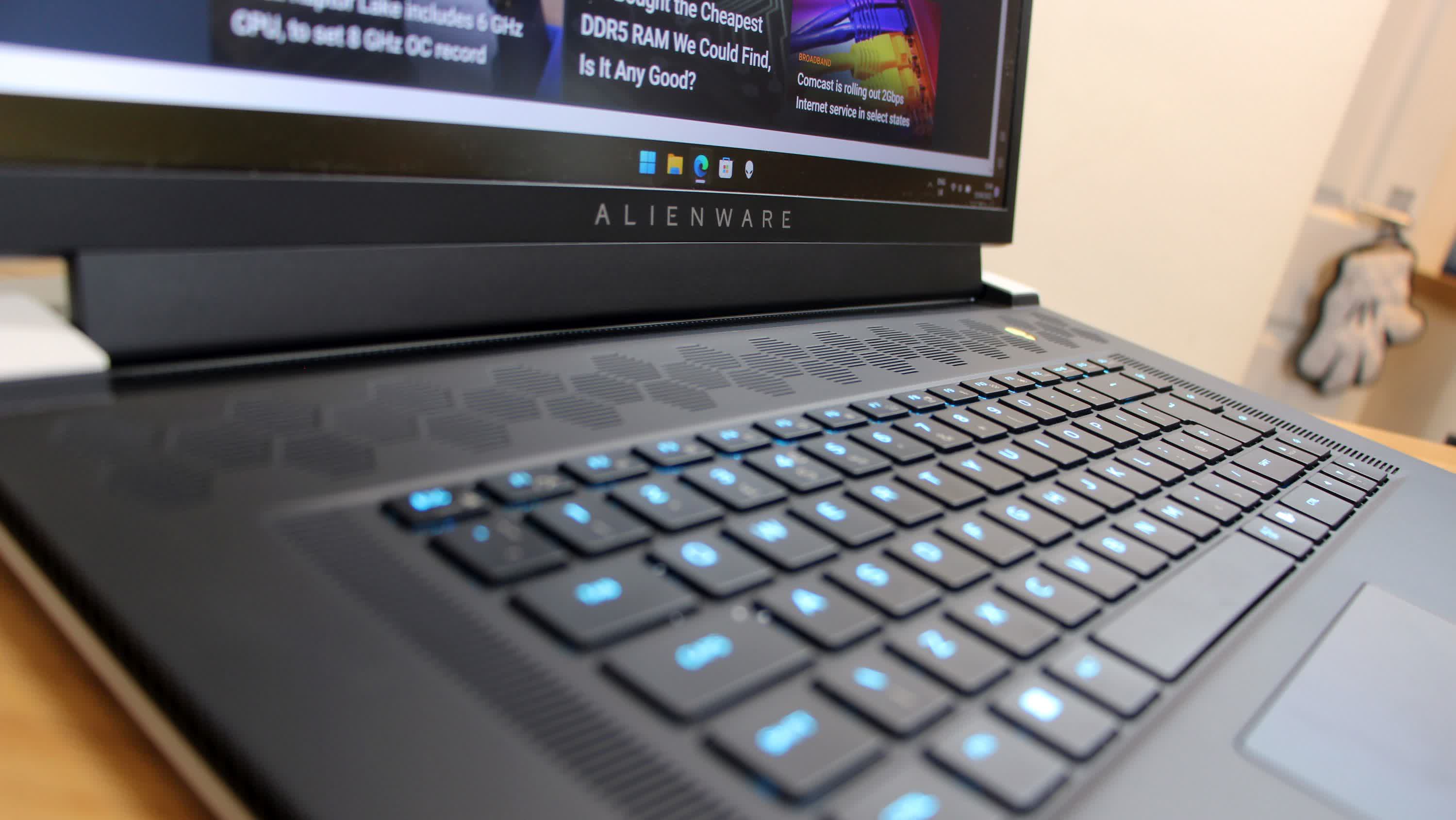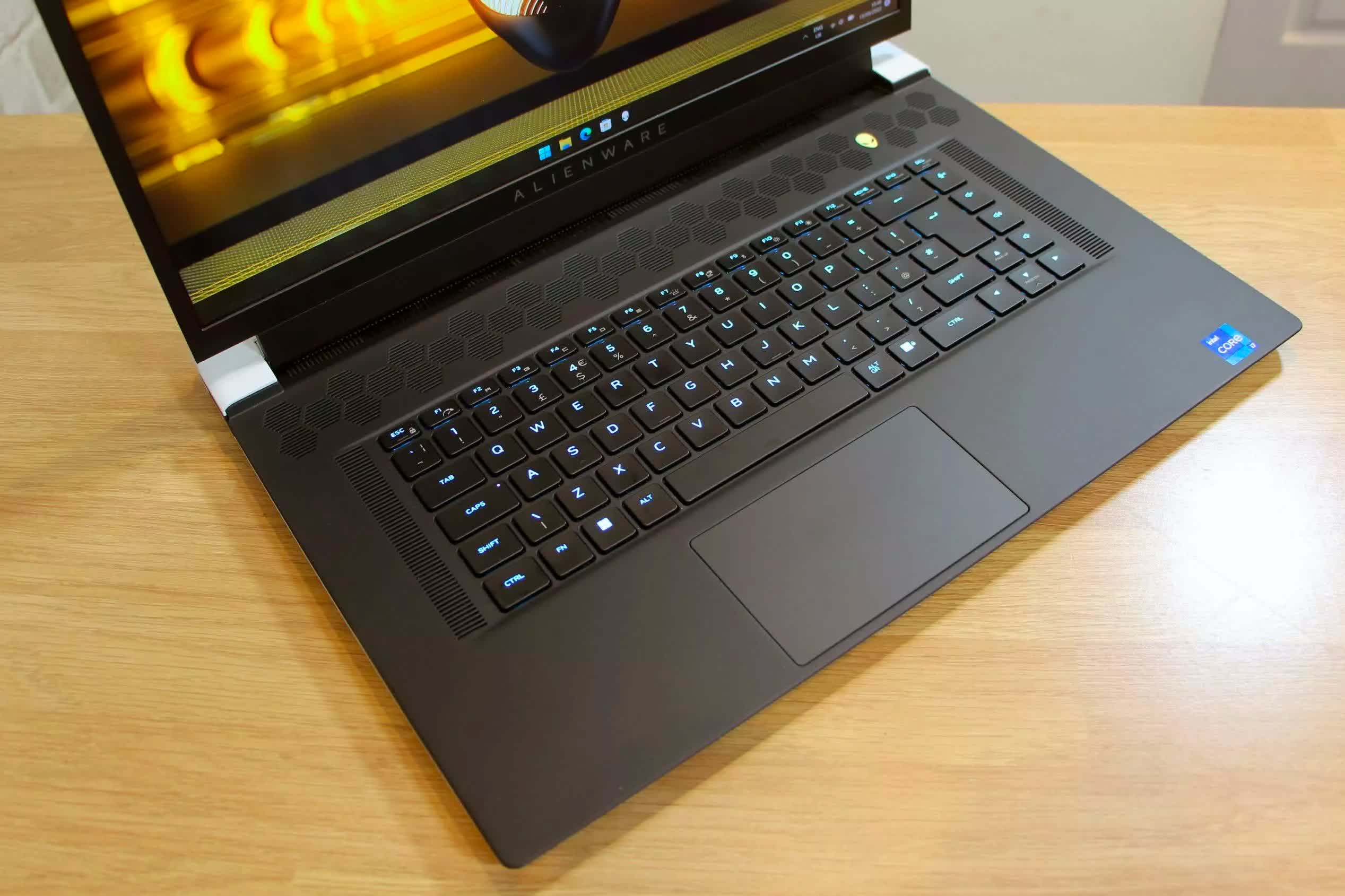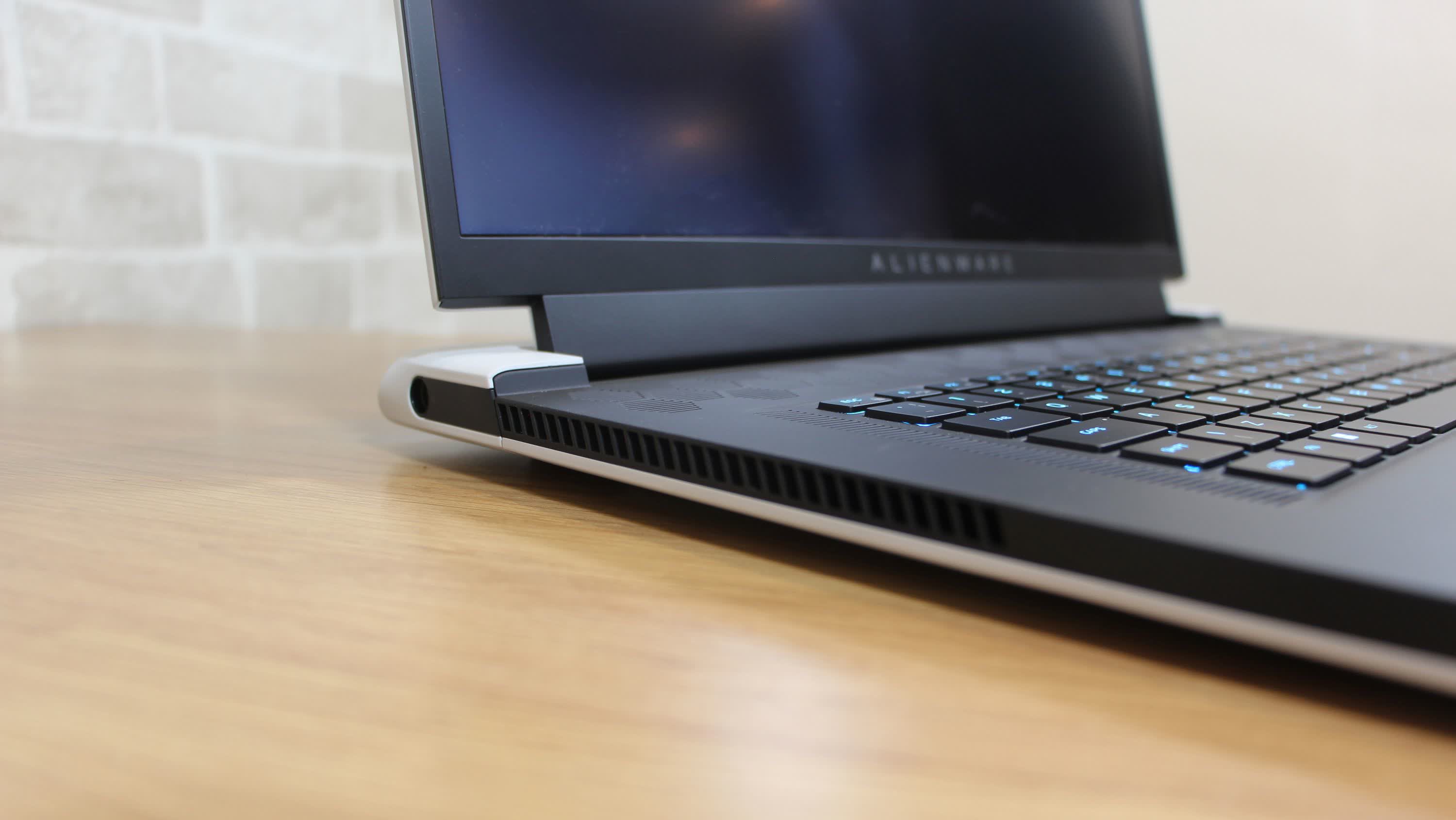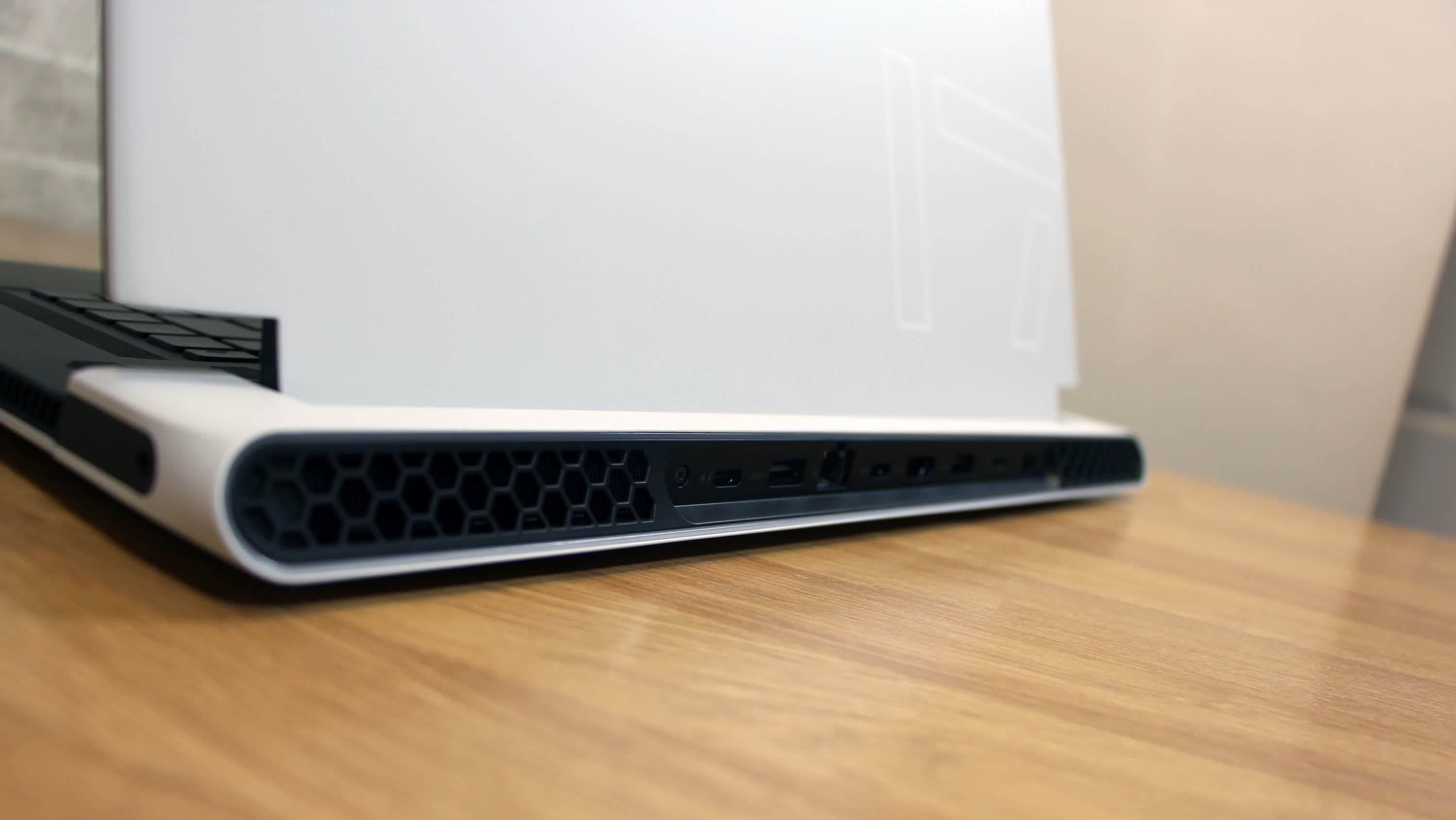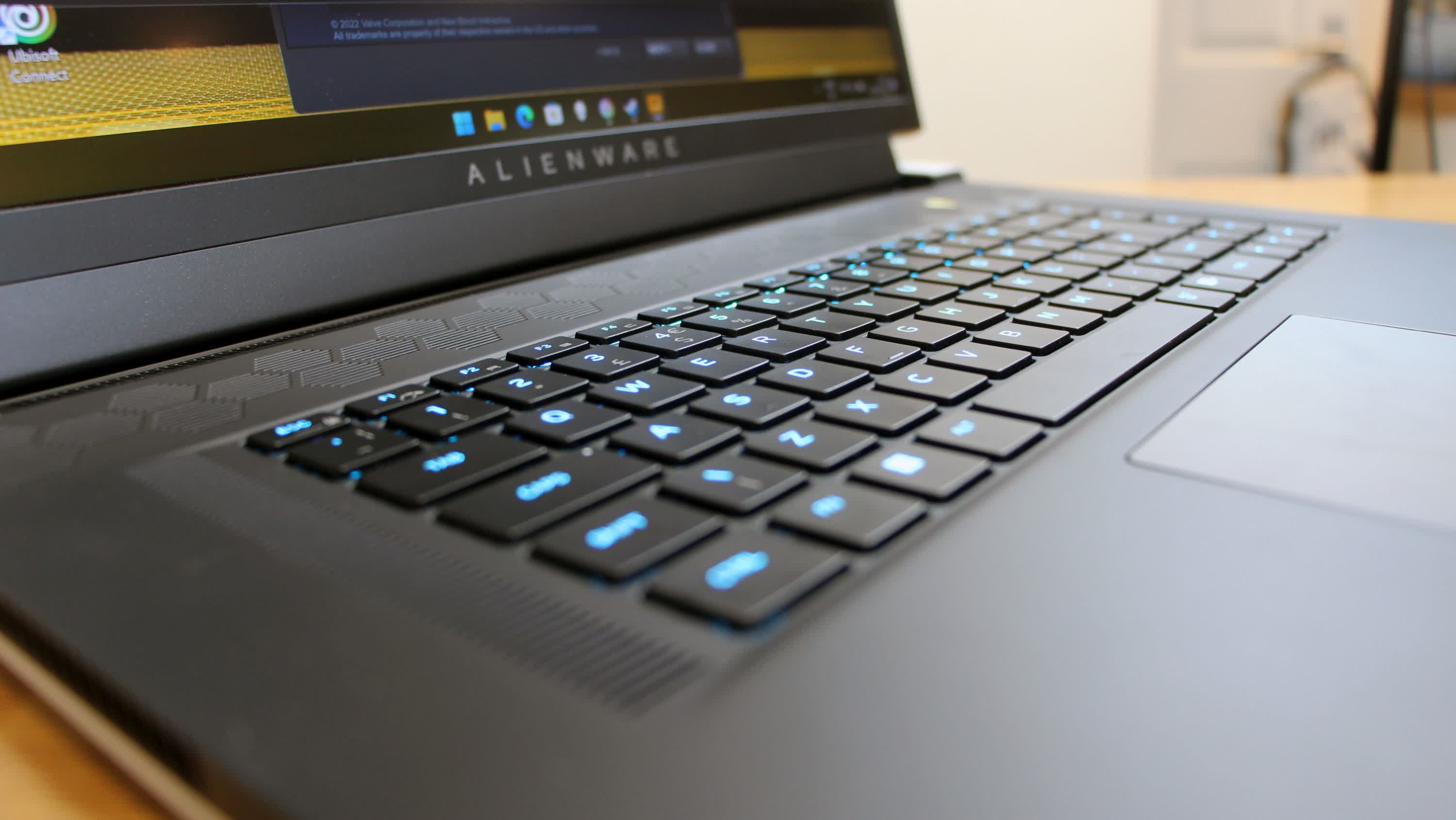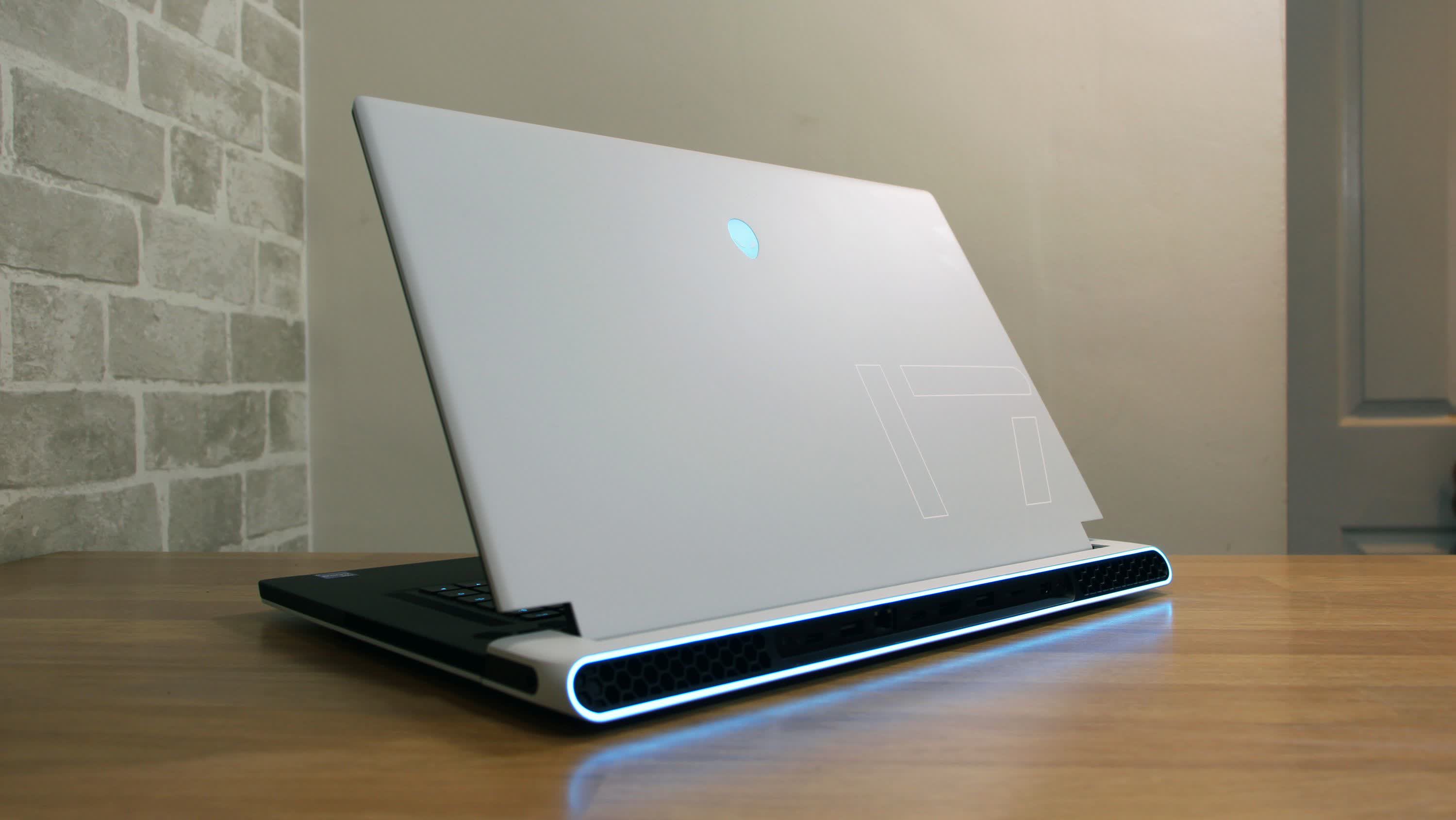The Alienware x17 R2 is the company's latest assault on the gaming laptop market, and you'll find plenty to like here as soon as you slide this machine from its box. The x17 deploys Alienware's eye-catching and now familiar Legend 2.0 design language, with the sheer size of this notebook signaling that you're in for an immersive and enjoyable gaming experience.
On the inside, Alienware's notebook pairs range-topping Nvidia graphics with a muscular Intel processor and a fast screen with G-Sync. The rig we've reviewed came in with Nvidia's RTX 3080 Ti and an Intel Core i7-12700H alongside 32GB RAM and a 2TB SSD, it will set you back $3,499. As is to be expected, Alienware laptops aren't particularly cheap. The most affordable x17 R2 still demands $2,249 from your wallet.
That's big bucks to spend on a gaming laptop, and it might prove too much when the Alienware x17 R2 faces strong competition from the likes of Razer and Asus.
Features and Design
Regardless of what those rivals look like, no-one could accuse the Alienware of being shy. The design combines a white exterior with black interior, and the combined colors look excellent. There's a huge "17" motif on the lid, and familiar Alienware touches abound...
The power button is an Alienware logo, and the speaker grilles and cooling vents use a honeycomb shape. Slim screen bezels and a ring of RGB LEDs around the rear ports complete the overall look.
The Alienware looks fantastic and there's no doubt that it takes a different path from its closest rivals. An alternative like the Razer Blade 17 is subtle, with an all-black design and fewer RGB, while the flagship Asus ROG Strix Scar 17 goes in the opposite direction, with loads of glow, translucent plastic and a more traditional "gamer" notebook style.
The Alienware sits somewhere between the two, balancing a mature aesthetic with the striking visuals that plenty of people expect from top-tier gaming notebooks.
The dimensions are reasonable, too. The x17 R2 is 21mm thick, which means it's slimmer than top gaming notebooks from Asus and barely thicker than the sleek Razer. At 6.61 pounds on the scales, the x17 R2 is a tad heavier than most of its competitors, but the gap isn't huge and you won't notice differences between the Alienware and its competitors – when you buy a 17.3" gaming notebook you're going to have to accept having a weighty laptop in your bag. And while the power brick weighs 1.9 pounds, that's entirely normal in this segment.
Happily, the heft is justified by the impressive build quality. There's hardly any give in the display, the wrist-rest barely moves and the underside is sturdy. We have no qualms about carrying this rig around and the magnesium-aluminum alloy casing does a brilliant job.
There's a welcome practical touch on the base, too. It's designed to be removed, so you don't have to spend uncomfortable minutes trying to prise the panel from around the laptop's edges, and on the inside you can access both memory slots and two M.2 SSD sockets. Removing the base panels from Razer laptops is harder, and on Asus machines you're scuppered by awkwardly-placed lighting cables.
The Display
The Alienware x17 R2 we tested pairs a 17.3" IPS non-touch display with a 4K resolution, 16:9 aspect ratio, and 3ms response time. The refresh rate is capped at 120Hz with Nvidia G-Sync support to ensure butter-smooth gaming.
It's an ideal specification for single-player gaming. The graphics card will struggle to drive refresh rates beyond 120Hz at 4K anyway, and 120 fps performance is easily ample to make most modern single-player titles look fantastic.
You'll need more speed if you're into esports or twitchy, fast-paced FPS games, in which case Alienware offers the x17 R2 with a 1080p screen that runs at 360Hz with a 1ms response time. That's great for competitive speed, and on this model it drops the price to $3,299.
Alienware also sells a 480Hz screen with this laptop, but we'd avoid that: the response time drops back down to 3ms, and the jump from 360Hz to 480Hz delivers diminishing returns. Add that display and our laptop jumps in price to a vast $3,749, too.
There are other more conventional options, too. Entry-level configurations have 1080p screens that run at 165Hz, which is ideal for mainstream single-player gaming and esports. And if you want a bit of extra sharpness, a 2,560 x 1,440 display at 165Hz is available, too.
We'd pick out the 4K and 1080p/360Hz screens as the best-value options, and the 4K screen we've reviewed delivered superb quality. The peak brightness level of 474cd/m2 is easily high enough to tackle indoor and outdoor gaming, and its accompanying black point of 0.44cd/m2 is decent. The resulting contrast ratio of 1,077:1 is solid for an IPS display, and means games have huge punch and nuance.
A deeper black point would have delivered even more depth and nuance to dark areas. But that's a tiny flaw that won't cause noticeable issues during gameplay, and titles are still vibrant and bold.
The Delta E of 2.91 is good and below the 3.0 point where most people will be able to detect deviations in color accuracy – for gaming, that's easily good enough. But you'll want to find a laptop with a sub-2.0 Delta E if you need to tackle color-sensitive creative workloads. The color temperature of 6,671K is well-balanced – we have no issues there.
Alienware's 4K screen rendered 98.6% of the sRGB color gamut at 139.7% volume. Those are excellent figures that will translate in games showing lashings of energetic color. Elsewhere, the panel produces 94.4% of the DCI-P3 color space at 99% volume – more good figures, even though this isn't an HDR display.
This 4K screen only generated 84.8% of the Adobe RGB color space, though. That's not good enough for color-sensitive work in Adobe tools – combine this with the Delta E and you've got a screen that won't quite sate creative professionals.
For gaming, though, it's superb: crisp, smooth and dynamic, with vivid colors. The speakers have plenty of punch with loud, bassy output. They certainly make games boom, but the top-end is slightly tinny, and anyone who wants a better gaming experience should invest in a headset.
Input and Connectivity
The Alienware x17 keyboard's got per-key RGB LED backlighting that's bright, sharp and easy to customize in the AlienFX software, and its stainless steel butterfly switches have 1.5mm of travel, n-key rollover and anti-ghosting tech.
The buttons are snappy and quick, with pleasing, crisp action and solid strength beneath. They're not far short of the best low-profile mechanical units you'll find on some laptops, and this keyboard is sturdy enough to cope with long gaming sessions.
It's more satisfying and has more heft than the shallow units on Razer notebooks, and is just as good as Asus hardware. If you're willing to pay an extra $50, you can upgrade to a CherryMX low-profile mechanical keyboard with 1.8mm of travel. It's a more tactile design and will please those who want a weightier, faster experience.
Our only quibbles concern the layout. On the right-hand edge of the keyboard there's an extra column of media buttons, but no numpad. That's going to disrupt some people's control schemes, and it's disappointing when the Alienware is so large. Razer's notebooks follow suit, while flagship Asus rigs do include a numpad.
The trackpad presents no surprises. It's large and responsive, and buttons are relatively crisp, but anyone who wants to properly enjoy games should use a mouse instead.
You'll find all of the Alienware's ports around the back, which is good for cable-tidying but potentially awkward for easy access. The ring of RGB LEDs at the rear makes them tricky to see, too: the lights are so bright that the ports often seem invisible.
The x17 boasts two USB 3.2 Gen 1 ports, a USB 3.2 Gen 2 Type-C port and one Thunderbolt 4 port – and all of those have power delivery. There's an HDMI 2.1 port for future-proofed 4K/120Hz and 8K/60Hz outputs alongside a mini-DisplayPort output. Creatives will be pleased with a microSD card slot.
Dell's notebook has dual-band 802.11ax wireless that's pre-certified for Wi-Fi 6E, Bluetooth 5.2, and 2.5Gbps Ethernet, too.
Above the display is a webcam with Windows Hello support, so you can still use biometric login despite the machine's lack of fingerprint reader. It's a shame that the camera isn't 1080p, though – it's only 720p.
This is good connectivity for gaming and work, but other gaming laptops are sometimes better. Razer's Blade 17 has three full-size USB ports, an SD card reader, two Thunderbolt ports and a 1080p webcam. The larger Asus ROG Strix Scar 17 matches the Alienware in terms of physical connectivity, but that rig has a 1080p webcam, too.
Performance
The Alienware x17 R2 can pack flagship components with ambitious configurations. The Nvidia GeForce RTX 3080 Ti deploys its usual 7,424 stream processors and 16GB of memory, and it can reach its peak power limit of 175W. It even draws a maximum of 150W when none of those overclocked options are active, so you'll always get plenty of gaming grunt – expect GPU speeds beyond 1600MHz.
On the processing side, Intel's Core i7-12700H (read our full review) has six hyper-threaded P-cores with base and boost speeds of 2.3GHz and 4.7GHz, and its eight E-cores deliver speeds of 1.7GHz and 3.5GHz, respectively.
The specification is completed with 32GB of dual-channel DDR5 memory at 4800MHz and a 2TB Samsung PM9A1 PCIe 4.0 SSD with read and write speeds of 6,979 MB/s and 5,088 MB/s.
We've already taken deep dives into these core components: so you should check out our full reviews for an in-depth examination of the Intel Core i7-12700H and our dedicated review of the RTX 3080 Ti laptop core.
The x17's RTX 3080 Ti delivered impressive pace. At 1080p you'll able to play anything: the tough Assassin's Creed Valhalla averaged 89 fps with every setting ramped up, and in Red Dead Redemption 2 the Alienware averaged 102.65 fps. Those speeds are easily high enough to make single-player games look smooth on this 120Hz display.
There's enough power to game 4K, too. An Assassin's Creed average of 45 fps with every graphics setting activated is high enough to play the game smoothly on most occasions – the 30 fps minimum means you'll only see modest, occasional performance dips. The Alienware hit 56.38 fps in Red Dead Redemption 2, with a strong minimum of 42.75 fps.
You'll only have to dial back the graphics settings a little if you want to hit a consistent 60 fps in the trickiest titles – and in less-demanding games you won't have to do anything, as a 73 fps average in Far Cry New Dawn shows.
The x17 performs well in other situations. Activate DLSS in supported titles and you'll only have to make modest graphics reductions to ensure consistent performance with some ray tracing effects. The mobile RTX 3080 Ti will tackle VR headsets, too, if needed.
There's plenty of pace available in top esports games. In Tom Clancy's Rainbow Six Siege at 1080p a minimum of 271 fps and 331 fps average are both superb, and you'll be able to sate the 360Hz and 480Hz display options with minimal tweaking. Lots of esports games are less demanding than Rainbow Six, too, which bodes well for broad performance.
There's no doubt that the RTX 3080 Ti is quick, but not everyone needs this much gaming performance. If you do find yourself in that position, this machine costs $3,109 with an RTX 3070 Ti – and the price remains the same if you opt for the 2,560 x 1,440 display. It's also possible to configure this laptop with the RTX 3060, which starts at $2,499 depending on display you choose, although that will cut back on overall gaming performance, of course.
There are a couple of other pricing tips we'd recommend. Our review rig might have a spacious 2TB SSD, but halving its capacity drops the price by $200 – ideal if you know you'll only install a few games. And if you don't want a laptop for creative workloads, you can save $150 by dropping down from 32GB of DDR5 to 16GB.
The Alienware continued to perform well in application benchmarks. In Cinebench R23's single- and multi-core benchmarks the x17 R2 returned scores of 1,779 and 18,517. They're fantastic results: the former is on par with the scores we recorded from the chip in our standalone review, and the latter is even further ahead of the standalone result gained from the 75W version of the CPU.
Those results also see the Alienware's processor outpace AMD's Ryzen 7 5800H and they're also faster than what you'll see from the newer Ryzen 7 6800H and Apple M2 CPUs. The only way to get more processing power in a laptop is by upgrading to a Core i9-12900H or i9-12900HK, which are also available to configure in the Alienware but madly expensive.
There's not a huge amount of clear air between the Core i7 and Core i9 chips, so the upgrade is only worthwhile if you're desperate for every ounce of content-creation power. It's not like the i7-12700H is slow: it's already powerful enough to handle tough multi-tasking, photo and video-editing and tricky content creation workloads, and you'll only get a meaningful improvement if you move to a proper desktop.
The Alienware x17's application performance is great, but not flawless. Its Matlab result of 1.05 seconds is marginally behind what we extracted from the chip in our review, and its Excel benchmark time of 7.51 seconds also sits a little behind the review chip. The PCMark 10 Essentials score of 10,337 follows suit, and its 7-Zip compression and decompression results arrived at 61.4 MB/s and 781.1 MB/s.
While it's true that the i7-12700H in the Alienware doesn't quite match the maximum possible speeds that this chip can achieve, it shouldn't be an issue unless you're chasing peak performance. The i7-12700H in this laptop does manage to outpace rival chips in many benchmarks – at its worst, it competes well with the Ryzen 7 6800H.
Throttling explains those slightly reduced speeds. In single-core workloads the i7-12700H its stated top speed of 4.7GHz on its P-cores, but in multi-threaded tasks it peaked at 3.9GHz. This situation remained consistent across the laptop's various overclocked performance modes.
Thermals and Battery Life
Alienware makes a big deal about the x17's Cryo-Tech cooling hardware and Element 31 thermal interfacing material and the results are pretty solid. Even while overclocking the x17 and running on performance mode, the laptop's noise output never rose beyond 46db, which is great considering the hardware inside – it's not unusual for top-end gaming laptops to soar past 50db.
The x17 was a few decibels quieter when tackling non-gaming workloads, and during modest everyday tasks it was virtually silent. The external heat levels aren't bad, either. The metal above the keyboard did become too warm to touch for any length of time during intense gaming or work sessions, but that's not unusual for a gaming laptop and it's not an area that people tend to touch.
Beyond that, the panels were warm but not hot. And while that could become uncomfortable if the Alienware is on your lap, that's not likely to happen too often – this 6.61 pound machine is better rooted to a desk.
That's all the more likely considering the Alienware's battery life. Our best results came when playing movies with the screen running at 50% brightness – and, even then, the x17 ran out of juice after 3 hours and 52 minutes. That figure dropped by 30 minutes with increased display brightness.
When performing everyday tasks, the Alienware's battery lifespan ranged between 2 hours and 35 minutes and 2 hours and 53 minutes depending on the display brightness, but when gaming the Alienware never lasted beyond 43 minutes. Combine that with the reduced GPU ability on battery power and you've got a laptop that only excels when it's plugged in.
The Alienware is hardly alone when it comes to poor battery life, though, and there are plenty of areas where the x17 R2 is more impressive.
Wrap Up
Crucially, the Alienware x17 R2 is a brilliant gaming performer. It's got the pace to tackle any mainstream game, from the most demanding single-player titles to the fastest esports games, and it will play almost all of them with hardly any adjustments – you're either going to play titles at top settings or very close to that.
The processor is quick, too, with loads of power for content-creation. Elsewhere, Alienware's rig has fast storage, a high-quality keyboard, a 4K screen with vibrant colors and decent everyday connectivity. We didn't find any glaring issues with the x17 R2. Some people might find the lack of a numpad irritating, and battery life is unsurprisingly poor.
The Alienware offers relatively good value within its segment. The model we've reviewed costs $3,499, but can be $200 cheaper if you halve the SSD capacity. The Razer Blade 17 costs $3,999 if you pair an RTX 3080 Ti with a 360Hz display or $4,299 if you want a 4K panel and a Core i9 CPU. The range-topping Asus ROG Strix Scar 17 sits at $3,499 for a laptop with an RTX 3080 Ti and a beefy Core i9-12950HX processor, but it's not available with 4K or 360Hz screens.
Bottom line, the Alienware x17 R2 offers huge performance and great screen and keyboard quality inside a robust, good-looking chassis. It's expensive and only worthwhile if you're a particularly demanding gamer, but it's an excellent high-end choice.
